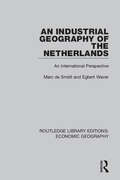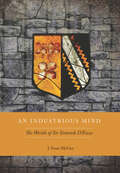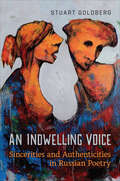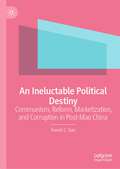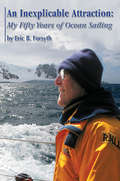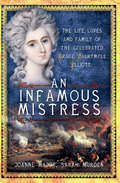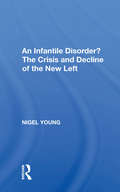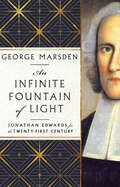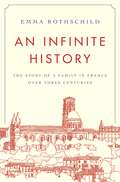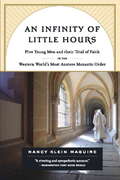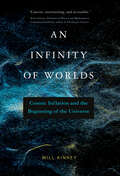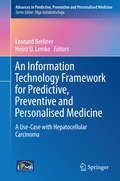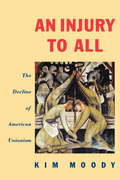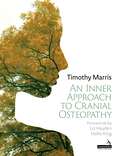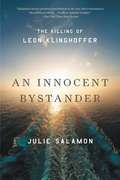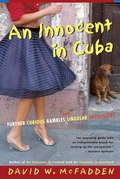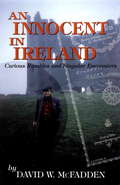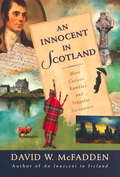- Table View
- List View
An Industrial Geography of the Netherlands: An International Perspective (Routledge Library Editions: Economic Geography)
by Egbert Wever Marc de SmidtThis book, originally published in 1990, provides a comprehensive and detailed assessment of the Dutch economy since the war, discussing the changes which have been brought about by the restructuring of the economic base. The book employs case studies to analyse in particular the impact of regional policy, the position of the country in the international industrial network and the impact of large industrial concerns, foreign and domestic, on the Dutch economy.
An Industrious Mind: The Worlds of Sir Simonds D'Ewes
by J. Sears McgeeThis is the first biography of Sir Simonds D'Ewes, a member of England's Long Parliament, Puritan, historian and antiquarian who lived from 1602-1650. D'Ewes took the Puritan side against the supporters of King Charles I in the English Civil War, and his extensive journal of the Long Parliament, together with his autobiography and correspondence, offer a uniquely comprehensive view of the life of a seventeenth-century English gentleman, his opinions, thoughts and prejudices during this tumultuous time. D'Ewes left the most extensive archive of personal papers of any individual in early modern Europe. His life and thought before the Long Parliament are carefully analyzed, so that the mind of one of the Parliamentarian opponents of King Charles I's policies can be understood more fully than that of any other Member of Parliament. Although conservative in social and political terms, D'Ewes's Puritanism prevented him from joining his Royalist younger brother Richard during the civil war that began in 1642. D'Ewes collected one of the largest private libraries of books and manuscripts in England in his era and used them to pursue historical and antiquarian research. He followed news of national and international events voraciously and conveyed his opinions of them to his friends in many hundreds of letters. McGee's biography is the first thorough exploration of the life and ideas of this extraordinary observer, offering fresh insight into this pivotal time in European history.
An Indwelling Voice: Sincerities and Authenticities in Russian Poetry
by Stuart GoldbergHow have poets in recent centuries been able to inscribe recognizable and relatively sincere voices despite the wearing of poetic language and reader awareness of sincerity’s pitfalls? How are readers able to recognize sincerity at all given the mutability of sincere voices and the unavailability of inner worlds? What do disagreements about the sincerity of texts and authors tell us about competing conceptualizations of sincerity? And how has sincere expression in one particular, illustrative context – Russian poetry – both changed and remained constant? An Indwelling Voice grapples, uniquely, with such questions. In case studies ranging from the late neoclassical period to post-postmodernism, it explores how Russian poets have generated the pragmatic framings and poetic devices that allow them to inscribe sincere voices in their poetry. Engaging Anglo-American and European literature, as well as providing close readings of Russian poetry, An Indwelling Voice helps us understand how poets have at times generated a powerful sense of presence, intimating that they speak through the poem.
An Ineluctable Political Destiny: Communism, Reform, Marketization, and Corruption in Post-Mao China
by Forest C. SunThis book offers comprehensive review and analysis of official corruption in post-Mao China, arguing that this complex political and social malaise is the consequence of a variety of contributing factors, which include political, social, traditional/cultural, or structural, institutional, governance or policy failures. This study distinguishes itself from the methodologies of other studies by classifying corruption into detailed categories and sub-categories, accompanied by abundant cases and examples of the irregularities and offences. Contents are organized into four categories – bureaucratic corruption, regulatory corruption, corruption in judiciary, and corruption characteristic of socialist reform China, and each category is further divided into detailed subcategories to pin down the patterns, actors, loci, as well as inducements of corruption originated from either political institutions, economic structures, or sociocultural norms. Given its comprehensiveness and in-depth of information and analysis, this book is a useful reference for those interested in political and government corruption in post-Mao China.
An Inexplicable Attraction: My Fifty Years Of Ocean Sailing
by Eric B. ForsythSailing well into his eighties, Captain Eric Forsyth shows in his book, An Inexplicable Attraction: My Fifty Years of Ocean Sailing, that age need not be a barrier to an adventurous retirement. His love of ocean sailing was ignited in 1964 when he crossed the Atlantic with his wife, Edith, crewing aboard a friend’s 46-foot boat. For more than fifty years, mostly aboard his sturdy cutter Fiona, Forsyth has cruised the oceans of the world, making voyages that included two circumnavigations of the globe, cruises through the Northwest Passage and to the Baltic, and several excursions to both the Arctic and Antarctic. His stories will appeal to all sailors, whether active or armchair, and to travel buffs with a penchant for remote places and their histories. On a more serious side, Forsyth has seen many countries that he visited over the decades change from languorous oligarchies to developing democracies with a thriving middle class. Like the U.S., they have a profligate appetite for fossil fuel, which is not a sustainable resource in the long run. He suggests ways of bringing attention to this global problem. Captain Forsyth has been honored by fellow sailors with the Seven Seas Award from the Seven Seas Cruising Association, and the Blue Water Medal, given annually by the Cruising Club of America to a single amateur sailor worldwide.
An Infamous Mistress: The Life, Loves and Family of the Celebrated Grace Dalrymple Elliott
by Joanne Major Sarah Murden&“Courtesan. Spy. Survivor. A gripping and meticulously researched account of the swashbuckling life of one of history&’s most overlooked heroines.&” —Hallie Rubenhold, author of The Five Divorced wife, infamous mistress, prisoner in France during the French Revolution, and the reputed mother of the Prince of Wales&’ child, notorious courtesan Grace Dalrymple Elliott lived an amazing life in eighteenth- and early nineteenth-century London and Paris. Strikingly tall and beautiful, later lampooned as &“Dally the Tall&” in newspaper gossip columns, she left her Scottish roots and convent education behind to reinvent herself in a &“marriage à-la-mode,&” but before she was even legally an adult she was cast off and forced to survive on just her beauty and wits. The authors of this engaging and, at times, scandalous book intersperse the story of Grace&’s tumultuous life with a family history that traces her ancestors from their origin in the Scottish borders, to their move south to London. It follows them to France, America, India, Africa, and elsewhere, offering a broad insight into the social history of the Georgian era, comprising the ups and downs, the highs and lows of life at that time. &“A fascinating read . . . a shining example of research done well, presented coherently on the perfect subject: a powerful courtesan that time forgot.&” —History of Royals &“Set for the first time in the context of Grace&’s wider family, this is a compelling tale of scandal and intrigue.&” —Scots Heritage Magazine
An Infantile Disorder?: The Crisis And Decline Of The New Left (Routledge Library Editions: The Labour Movement Ser. #44)
by Nigel YoungFirst published in 1977. The New Left, as an organised political phenomenon, came - and went - largely in the 1960s. Was the Movement that went into precipitate decline after 1969 the same New Left that had developed a decade earlier? Nigel Young's thesis is that the core New Left, as it had evolved by the mid-1960s, had a unique identity that set
An Infantile Disorder?: The Crisis and Decline of the New Left (Routledge Library Editions: The Labour Movement #44)
by Nigel YoungFirst published in 1977. The New Left, as an organised political phenomenon, came – and went – largely in the 1960s. Was the Movement that went into precipitate decline after 1969 the same New Left that had developed a decade earlier? Nigel Young’s thesis is that the core New Left, as it had evolved by the mid-1960s, had a unique identity that set it apart from other Old Left and Marxist groups. He believes that this was dissipated in the later developments of the black and student movements, and in the opposition to the Vietnam war. By 1968 – the watershed year – an acute ‘identity-crisis’ had set in within the Movement and became the major source of the New Left’s disintegration. Nigel Young traces the Movement’s growth and crisis mainly in Britain and America, where it reached its greater strength, but attention is also paid to parallel developments in similar movements elsewhere. He analyses the crisis in terms of the interrelationship between dilemmas of strategy and ideas, and the external events which tend to reinforce the tendencies toward elitism, intolerance and violence, and produce organisational breakdown.
An Infantry Officer with the Eighth Army: The Personal Experiences of an Infantry Officer During the Eighth Army’s Campaign Through Africa and Sicily
by Major H. P. SamwellFirst published posthumously in 1945, this is a descriptive account by Major H. P. Samwell, MC of his experiences serving as an Infantry Officer with the Desert Army in the Western Desert and Sicily between 1942 and 1943.A rare account of the North African campaign as it happened, day-by-day, and includes Samwell’s thoughts from the frontline regarding the problems of occupation in Italy.-Print ed.
An Infinite Fountain of Light: Jonathan Edwards for the Twenty-First Century
by George M. MarsdenChristians need to pause once in a while to get their bearings. For perspective on our own times and how we got here, it helps to listen to wise guides from other eras. In An Infinite Fountain of Light, the renowned American historian George Marsden illuminates the landscape with wisdom from one such mentor: Jonathan Edwards. Drawing on his deep expertise on Edwards and American culture, Marsden explains where Edwards stood within his historical context and sets forth key points of his complex thought. By also considering Benjamin Franklin and George Whitefield, two of Edwards's most influential contemporaries, Marsden unpacks the competing cultural and religious impulses that have shaped our times. In contrast, Edwards offered us an exhilarating view of the centrality of God's beauty and love. Christians' love for God, he taught, can be the guiding love of our lives, opening us to transformative joy and orienting all our lesser loves. "There is an infinite fullness of all possible good in God, a fullness of every perfection, of all excellency and beauty, and of infinite happiness," wrote Edwards. "This infinite fountain of light should, diffusing its excellent fullness, pour forth light all around." With Marsden's guidance, readers will discover how Edwards's insights can renew our own vision of the divine, of creation, and of ourselves.
An Infinite History: The Story of a Family in France over Three Centuries
by Emma RothschildAn innovative history of deep social and economic changes in France, told through the story of a single extended family across five generationsMarie Aymard was an illiterate widow who lived in the provincial town of Angoulême in southwestern France, a place where seemingly nothing ever happened. Yet, in 1764, she made her fleeting mark on the historical record through two documents: a power of attorney in connection with the property of her late husband, a carpenter on the island of Grenada, and a prenuptial contract for her daughter, signed by eighty-three people in Angoulême. Who was Marie Aymard? Who were all these people? And why were they together on a dark afternoon in December 1764? Beginning with these questions, An Infinite History offers a panoramic look at an extended family over five generations. Through ninety-eight connected stories about inquisitive, sociable individuals, ending with Marie Aymard’s great-great granddaughter in 1906, Emma Rothschild unfurls an innovative modern history of social and family networks, emigration, immobility, the French Revolution, and the transformation of nineteenth-century economic life.Rothschild spins a vast narrative resembling a period novel, one that looks at a large, obscure family, of whom almost no private letters survive, whose members traveled to Syria, Mexico, and Tahiti, and whose destinies were profoundly unequal, from a seamstress living in poverty in Paris to her third cousin, the cardinal of Algiers. Rothschild not only draws on discoveries in local archives but also uses new technologies, including the visualization of social networks, large-scale searches, and groundbreaking methods of genealogical research.An Infinite History demonstrates how the ordinary lives of one family over three centuries can constitute a remarkable record of deep social and economic changes.
An Infinity of Little Hours: Five Young Men and Their Trial of Faith in the Western World's Most Austere Monastic Order
by Nancy Klein MaguireIn 1960, five young men arrived at the imposing gates of Parkminster, the largest center of the most rigorous and ascetic monastic order in the Western world: the Carthusians. This is the story of their five-year journey into a society virtually unchanged in its behavior and lifestyle since its foundation in 1084. An Infinity of Little Hours is a uniquely intimate portrait of the customs and practices of a monastic order almost entirely unknown until now. It is also a drama of the men's struggle as they avoid the 1960s-the decade of hedonism, music, fashion, and amorality-and enter an entirely different era and a spiritual world of their own making. After five years each must face a choice: to make "solemn profession" and never leave Parkminster; or to turn his back on his life's ambition to find God in solitude. A remarkable investigative work, the book combines first-hand testimony with unique source material to describe the Carthusian life. And in the final chapter, which recounts a reunion forty years after the events described elsewhere in the book, Nancy Klein Maguire reveals which of the five succeeded in their quest, and which did not.
An Infinity of Nations: How the Native New World Shaped Early North America
by Michael WitgenAn Infinity of Nations explores the formation and development of a Native New World in North America. Until the middle of the nineteenth century, indigenous peoples controlled the vast majority of the continent while European colonies of the Atlantic World were largely confined to the eastern seaboard. To be sure, Native North America experienced far-reaching and radical change following contact with the peoples, things, and ideas that flowed inland following the creation of European colonies on North American soil. Most of the continent's indigenous peoples, however, were not conquered, assimilated, or even socially incorporated into the settlements and political regimes of this Atlantic New World. Instead, Native peoples forged a New World of their own. This history, the evolution of a distinctly Native New World, is a foundational story that remains largely untold in histories of early America. <p><p> Through imaginative use of both Native language and European documents, historian Michael Witgen recreates the world of the indigenous peoples who ruled the western interior of North America. The Anishinaabe and Dakota peoples of the Great Lakes and Northern Great Plains dominated the politics and political economy of these interconnected regions, which were pivotal to the fur trade and the emergent world economy. Moving between cycles of alliance and competition, and between peace and violence, the Anishinaabeg and Dakota carved out a place for Native peoples in modern North America, ensuring not only that they would survive as independent and distinct Native peoples but also that they would be a part of the new community of nations who made the New World.the continent's indigenous peoples, however, were not conquered, assimilated, or even socially incorporated into the settlements and political regimes of this Atlantic New World. Instead, Native peoples forged a New World of their own. This history, the evolution of a distinctly Native New World, is a foundational story that remains largely untold in histories of early America.Through imaginative use of both Native language and European documents, historian Michael Witgen recreates the world of the indigenous peoples who ruled the western interior of North America. The Anishinaabe and Dakota peoples of the Great Lakes and Northern Great Plains dominated the politics and political economy of these interconnected regions, which were pivotal to the fur trade and the emergent world economy. Moving between cycles of alliance and competition, and between peace and violence, the Anishinaabeg and Dakota carved out a place for Native peoples in modern North America, ensuring not only that they would survive as independent and distinct Native peoples but also that they would be a part of the new community of nations who made the New World.
An Infinity of Worlds: Cosmic Inflation and the Beginning of the Universe
by Will KinneyWhat happened before the primordial fire of the Big Bang: a theory about the ultimate origin of the universe.In the beginning was the Big Bang: an unimaginably hot fire almost fourteen billion years ago in which the first elements were forged. The physical theory of the hot nascent universe—the Big Bang—was one of the most consequential developments in twentieth-century science. And yet it leaves many questions unanswered: Why is the universe so big? Why is it so old? What is the origin of structure in the cosmos? In An Infinity of Worlds, physicist Will Kinney explains a more recent theory that may hold the answers to these questions and even explain the ultimate origins of the universe: cosmic inflation, before the primordial fire of the Big Bang. Kinney argues that cosmic inflation is a transformational idea in cosmology, changing our picture of the basic structure of the cosmos and raising unavoidable questions about what we mean by a scientific theory. He explains that inflation is a remarkable unification of inner space and outer space, in which the physics of the very large (the cosmos) meets the physics of the very small (elementary particles and fields), closing in a full circle at the first moment of time. With quantum uncertainty its fundamental feature, this new picture of cosmic origins introduces the possibility that the origin of the universe was of a quantum nature. Kinney considers the consequences of eternal cosmic inflation. Can we come to terms with the possibility that our entire observable universe is one of infinitely many, forever hidden from our view?
An Information Technology Framework for Predictive, Preventive and Personalised Medicine: A Use-Case with Hepatocellular Carcinoma (Advances in Predictive, Preventive and Personalised Medicine #8)
by Leonard Berliner Heinz U. LemkeThis book explores how PPPM, clinical practice, and basic research could be best served by information technology (IT). A use-case was developed for hepatocellular carcinoma (HCC). The subject was approached with four interrelated tasks: (1) review of clinical practices relating to HCC; (2) propose an IT system relating to HCC, including clinical decision support and research needs; (3) determine how a clinical liver cancer center can contribute; and, (4) examine the enhancements and impact that the first three tasks will have on the management of HCC. An IT System for Personalized Medicine (ITS-PM) for HCC will provide the means to identify and determine the relative value of the wide number of variables, including clinical assessment of the patient -- functional status, liver function, degree of cirrhosis, and comorbidities; tumor biology, at a molecular, genetic and anatomic level; tumor burden and individual patient response; medical and operative treatments and their outcomes.
An Information Technology Surrogate for Religion: The Veneration of Deceased Family in Online Games
by William Sims BainbridgeThis book demonstrates principles of Ancestor Veneration Avatars (AVAs), by running avatars based on eleven deceased members of one family through ten highly diverse virtual worlds from the violent Defiance to the intellectual Uru: Myst Online, from the early EverQuest to the recent Elder Scrolls Online.
An Information Theoretic Approach to Econometrics
by Ron C. Mittelhammer George G. JudgeThis book is intended to provide the reader with a firm conceptual and empirical understanding of basic information-theoretic econometric models and methods. Because most data are observational, practitioners work with indirect noisy observations and ill-posed econometric models in the form of stochastic inverse problems. Consequently, traditional econometric methods in many cases are not applicable for answering many of the quantitative questions that analysts wish to ask. After initial chapters deal with parametric and semiparametric linear probability models, the focus turns to solving nonparametric stochastic inverse problems. In succeeding chapters, a family of power divergence measure-likelihood functions are introduced for a range of traditional and nontraditional econometric-model problems. Finally, within either an empirical maximum likelihood or loss context, Ron C. Mittelhammer and George G. Judge suggest a basis for choosing a member of the divergence family.
An Injury to All: The Decline of American Unionism
by Kim MoodyOver the past decade American labor has faced a tidal wave of wage cuts, plant closures and broken strikes. In this first comprehensive history of the labor movement from Truman to Reagan, Kim Moody shows how the AFL-CIO's conservative ideology of "business unionism" effectively disarmed unions in the face of a domestic right turn and an epochal shift to globalized production. Eschewing alliances with new social forces in favor of its old Cold War liaisons and illusory compacts with big business, the AFL-CIO under George Meany and Lane Kirkland has been forced to surrender many of its post-war gains. With extraordinary attention to the viewpoints of rank-and-file workers, Moody chronicles the major, but largely unreported, efforts of labor's grassroots to find its way out of the crisis. In case studies of auto, steel, meatpacking and trucking, he traces the rise of "anti-concession" movements and in other case studies describes the formidable obstacles to the "organization of the unorganized" in the service sector. A detailed analysis of the Rainbow Coalition's potential to unite labor with other progressive groups follows, together with a pathbreaking consideration of the possibilities of a new "labor internationalism. "
An Inland Voyage
by Robert Louis StevensonAn Inland Voyage recounts a canoe trip Stevenson and his friend Sir Walter Grindlay Simpson made in 1876. Setting out from Antwerp, Stevenson (in the Arethusa) and Simpson (in the Cigarette) paddled through Belgium and France along canals and the Oise River. <P> <P> Much of the travelogue relates adventures the two men had along the way. Some of the more notable incidents include the travellers’ inability to use an Etna stove, watching a marionette show, and “being continually wetted with rain” (p. 91). At one point, Stevenson was left clinging to a tree after his canoe was swept away.Stevenson also describes many of the interesting people he and Simpson met. These included members of the Royal Sport Nautique and a family that lived on a barge.Thoughts on wider issues – such as the French character and politics, religion, and the artist’s role in society – also feature. <P> <P> The text includes, too, several philosophic moments, such as the following: <P> <P> “You may paddle all day long; but it is when you come back at nightfall, and look in the familiar room, that you find Love or Death awaiting you beside the stove; and the most beautiful adventures are not those we go to seek” (p. 121).
An Inner Approach to Cranial Osteopathy
by Timothy MarrisThis book is for the current Cranial Osteopathic practitioner. It looks into Cranial Osteopathy from a more profound 'inner' approach to help the practitioner to understand Cranial Osteopathy from a deeper and broader perspective. The book starts by taking the reader on an 'inner' journey of understanding more about themselves as the practitioner, discussing the 'osteopathic toolbox', and the need to be 'inner centred' when diagnosing and treating. It then looks at aspects of diagnosis - of tissue and fluid states - giving the reader several 'inner' considerations which they should apply when assessing a patient. The book then looks at the whole body and using an 'inner' approach to assess and treat each area. Each chapter gives an overview of the relevant anatomy and discusses the osteopathic relevance and new ways of working. Case studies/clinical experiences are described and 'hands on' exercises, which can be accessed via audio files, are given for the reader to practise. These exercises should be done 'at the treatment table' and will prepare the reader to use the approaches described with their patients. The audio leads the listener through a 'guided tour' of the anatomy and explains the exercise while they use their hands to feel what the author is describing.This guide will help Cranial Osteopathic practitioners enhance their skills, knowledge and understanding to a much-advanced level.
An Innocent Bystander: The Killing of Leon Klinghoffer
by Julie SalamonThe definitive story of one American family at the center of a single, shocking act of international terrorism that "manages to capture the essence of the Israeli-Palestinian conflict"(Dan Ephron) On October 3, 1985, Leon Klinghoffer, a disabled Jewish New Yorker, and his wife boarded the Achille Lauro to celebrate their 36th wedding anniversary with a Mediterranean cruise. Four days later, four Palestinian fedayeen hijacked the Italian luxury liner and took the passengers and crew hostage. Leon Klinghoffer was shot in the head, his body and wheelchair thrown overboard. His murder became a flashpoint in the intractable struggle between Israelis and Arabs and gave Americans a horrifying preview of what it means when terrorism hits home. In this richly reported book, drawing on multiple perspectives, Julie Salamon dispels the mythology that has grown around that shattering moment. What transpired on the Achille Lauro left the Klinghoffer family in the grip of irredeemable sorrow, while precipitating tragic reverberations for the wives and sons of Abu al-Abbas, the Palestinian mastermind behind the hijacking, and the family of Alex Odeh, a Palestinian-American murdered in Los Angeles in a brutal act of retaliation. Through intimate interviews with almost all living participants, including one of the hijackers, Julie Salamon brings alive the moment-by-moment saga of the hijacking and the ensuing U.S.-led international manhunt; the diplomatic wrangling between the United States, Egypt, Italy, and Israel; and the long agonizing search for justice. The book also reveals the back story of the controversial opera about the Klinghoffer tragedy that provoked a culture war. An Innocent Bystander is a masterful work of journalism that moves between the personal and the global with the pace of a geopolitical thriller and the depth of a psychological drama. Throughout lies the tension wrought by terrorism and its repercussions today.
An Innocent in Cuba
by David McfaddenWith An Innocent in Ireland (1995), David McFadden began his eccentric journeys to the heart of some of the world's most unique island nations. Now McFadden rambles through the highs and lows of Cuba, home to cigars, Guantanamera, and of course Castro. The beautiful Caribbean landscape, along with Cuba's rich history, culture, and uncertain future, lend themselves to the quirky eye and wry witticisms of our innocent Canadian guide.Poking into the nation's many corners, McFadden offers a series of vignettes of the people, cities,villages, roads, and countryside of the island the author refers to as "the most famous little country in the world." Warm and colourful, An Innocent in Cuba is a musical, sensuous, flirtatious, joyful tribute to the Cuban spirit in all its incarnations.
An Innocent in Ireland: Curious Rambles and Singular Encounters
by David McfaddenWhen writer David McFadden sets out on a tour of Ireland, he is determined to so do in a relatively innocent state. Using as a guide only In Search of Ireland, a 1930 title by travel writer H. V. Morton, he plans to follow the same route, to try to determine how things have changed and how they have remained the same.This he proceeds to do - at least at first. But soon he is wandering more and more erratically around the country, poking into any corner and musing over any sight that takes his fancy - from a cozy guest house in Kilcullen to the legendary Hill of Tara, from the south-coast pub run by twin sisters to the windswept reaches of the Ballaghbeama Gap. And increasingly he is drawn to the prehistoric monuments of ancient Ireland. As he goes, he records his very personal impressions in a clear-eyed and wryly humorous way.Wisely, McFadden also lets the many characters he meets speak for themselves; he loves a good chat and he gives ample space to the various loquacious barmen, shopkeepers, hoteliers, and passersby along the way. And of all the eccentric and appealing characters that he encounters, one of the most intriguing is his travelling companion, the mysterious Spanish chambermaid and poet Lourdes Brasil.Amusing, quirky, compassionate but unsentimental, An Innocent in Ireland is a treat for any armchair traveller.
An Innocent in Newfoundland: Even More Curious Rambles and Singular Encounters
by David McfaddenDavid McFadden travels around Newfoundland. Who knows which was most charmedIn An Innocent in Ireland (1995) and An Innocent in Scotland (1999), poet and traveller David McFadden let the spirit of the country - and his own interests - guide his rambles. He has now done the same in Newfoundland.Zigzagging across the province in his rented car, he charts an erratic course, admiring lawn sculpture (in his opinion a new local art), visiting fellow poets and publishers, wandering at dusk among the Viking mounds at L'Anse aux Meadows, rooming with a Salvation Army family in a distant outport (and discovering a family tragedy), hanging on in a stiff wind to watch birds nesting on a cliff face, and enjoying the social life in countless bars and restaurants.It soon becomes clear that McFadden's love of a good chat is shared widely by the people he meets in Newfoundland and he is wise enough to let them tell their own stories. For, as ever, his interest is in the heart of a place - and not just its scenery.Alert, somewhat eccentric, always ready to amuse and be amused, David McFadden is an ideal travelling companion.
An Innocent in Scotland: More Curious Rambles and Singular Encounters
by David McfaddenIn 1995, David W. McFadden published An Innocent in Ireland: Curious Rambles and Singular Encounters, a quirky and affectionate account of his travels around Ireland. In undertaking the trip, he chose as his guide H. V. Morton, the prolific travel writer of the 1920s and 1930s, whose In Search of Ireland (part of Morton's famous In Search of... series) had been familiar to him since childhood.Now, setting out to explore Scotland, his family's ancestral home, McFadden plans to use the same technique: to follow Morton's route around the country, observing how things have changed and in what ways they remain the same. As in An Innocent in Ireland, however, his own inquiring mind and engaging personality take over, and Morton appears less and less as McFadden becomes increasingly absorbed by the landscape - and particularly by the people.Starting in the Lowlands, he travels through Burns country (examining verses that Burns is alleged to have inscribed on a Dumfries window with his diamond ring) and up the east coast to the Highlands. There he lingers by Loch Ness (spotting nothing but tourists), before heading over to the west coast and falling in love with it - particularly with the islands of Mull and Iona. Through the entire trip, McFadden charts an erratic course, led only by H. V. Morton and his own acute eye and very lively curiosity. As he does so, he records his extremely personal impressions, which are wry, amused - and often more astute than he lets on.The reader won't find many of the traditional Scottish tourist sites in this account. Rather, as in An Innocent in Ireland, McFadden loves a good chat, and he wisely lets the many characters he meets speak for themselves. He gives generous attention to a variety of talkative barmen, hoteliers, shopkeepers, as well as to passersby that he encounters in the course of his travels. Their conversations, ranging from the instructive or humorous to the eccentric and even surreal, give a thoroughly entertaining view of a Scotland the guidebooks never reveal.Still quirky, affectionate, always ready to be intrigued or amused, David McFadden makes an ideal companion for any armchair traveller.
